Tlingit facts for kids
| Łingít | |
|---|---|
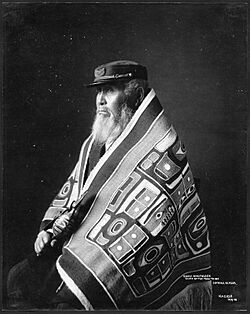 Chief Anotklosh of the Taku Tribe, wearing a Chilkat blanket, Juneau, Alaska, c. 1913 |
|
| Regions with significant populations | |
| United States (Alaska) | 22,601 (2020) |
| Canada (British Columbia, Yukon) | 2,110 |
| Languages | |
| English, Tlingit, Russian (historically) | |
| Religion | |
| Christianity, esp. Russian Orthodox Traditional Alaska Native religion |
|
| Łingít "People of the Tides" |
|
|---|---|
| People | Tlingit |
| Language | Łingít |
| Country | Tlingit Aaní |
The Tlingit or Lingít (pronounced TLING-kit or KLING-kit) are Indigenous peoples of the Pacific Northwest Coast of North America. As of 2022, they are recognized as two of the 231 official Tribes of Alaska. Most Tlingit people live in Alaska, United States, and some are First Nations in Canada.
Their special language is the Tlingit language, part of the Na-Dene language family. Tlingit people today belong to many recognized tribes. These include groups like the Angoon Community Association and the Central Council of the Tlingit & Haida Indian Tribes.
The Tlingit have a unique family system. Children belong to their mother's family group, called a clan. Important family roles and belongings are passed down through the mother's side. Their culture grew in the beautiful temperate rainforests of the southeast Alaskan coast. The Tlingit have always been skilled hunter-gatherers, especially good at managing fisheries.
Contents
What's in a Name?
The Tlingit call themselves Łingít. This name means 'People of the Tides'. It shows their strong connection to the ocean and its changing waters.
Where the Tlingit Live
Historically, the Tlingit lived in a large area. This stretched from the border of Alaska and British Columbia northwards. They lived along the coast and on many islands of the Alexander Archipelago. The Tlingit also controlled important mountain passes into the Yukon interior.
Some Tlingit groups lived along major rivers that flow into the Pacific Ocean. These rivers include the Alsek, Tatshenshini, and Taku. They traded a lot with other tribes who lived inland. This led to some Tlingit communities settling around lakes like Atlin and Teslin.
Today, Tlingit people live in both Canada and the United States. They do not have traditional reservations in Alaska. Instead, land is managed by regional corporations like Sealaska Corporation. Many Tlingit live in their historical homelands. They participate in Alaska's economy.
Different Tlingit Groups
The Tlingit lands can be divided into four main areas. These areas have different environments and ways of life:
- Southern Tlingit: Live where Western Red cedar trees grow.
- Northern Tlingit: Live in warmer forests with Sitka Spruce and Western Hemlock trees.
- Inland Tlingit: Live near large lakes and rivers in the Yukon. Their lifestyle is similar to other Athabascan groups.
- Gulf Coast Tlingit: Live along a narrow coast with steep mountains and glaciers. Pacific storms often hit their area.
These groups have slightly different cultures, food sources, and ways of speaking. They also trade with each other and with neighboring communities.
Tlingit Tribes or ḵwáans
The Tlingit people are organized into different tribes, called ḵwáans. Here are some of them:
| Tlingit Tribe | Translation | Main Village or Community |
|---|---|---|
| G̱alyáx̱ Ḵwáan | Salmon Stream Tribe | Yakataga-Controller Bay area |
| Xunaa Ḵáawu | Tribe from the North Wind | Hoonah |
| S'awdáan Ḵwáan | Jade-Colored Bay Tribe | Sedum |
| Tʼaḵjik.aan Ḵwáan: | Coast Town Tribe | northern Prince of Wales Island |
| Laax̱aayík Kwáan: | Inside the Glacier People | Yakutat area |
| Tʼaaḵu Ḵwáan: | Geese Flood Upriver Tribe | Taku |
| Xutsnoowú (a.k.a. Xudzidaa) Ḵwáan | Brown Bear Fort Tribe | Angoon |
| Hinyaa Ḵwáan | Tribe From Across The Water | Klawock |
| G̱unaax̱oo Ḵwáan | Among The Athabascans Tribe | Dry Bay |
| Deisleen Ḵwáan: | Big Sinew Tribe | Teslin |
| Shee Tʼiká (a.k.a. Sheetʼká) Ḵwáan | Outside Edge of a Branch Tribe | Sitka |
| Shtaxʼhéen Ḵwáan | Bitter Water Tribe | Wrangell |
| Séet Ká Ḵwáan | People of the Fast Moving Water | Petersburg |
| Jilḵáat Ḵwáan | Salmon Cache Tribe | Klukwan |
| Áa Tlein Ḵwáan | Big Lake Tribe | Atlin |
| Ḵéex̱ʼ Kwáan | Dawn Tribe | Kake |
| Taantʼa Ḵwáan | Sea Lion Tribe | Ketchikan (today) |
| Jilḵoot Ḵwáan | Chilkoot Tribe | Haines |
| Áakʼw Ḵwáan | Small Lake Tribe | Auke Bay |
| Kooyu Ḵwáan | Stomach Tribe | Kuiu Island |
| Saanyaa Ḵwáan | Southward Tribe | Saxman (today) |
Tlingit Culture and Traditions
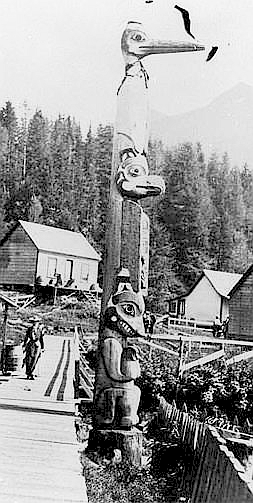
Tlingit culture is rich and detailed. It is known for its strong focus on family and community. Storytelling and public speaking are also very important. Being generous and behaving well are highly valued. These traits show good upbringing and connections to respected families.
Art and spiritual beliefs are part of almost everything in Tlingit life. Even everyday items like spoons and storage boxes are decorated. These decorations often tell stories or show spiritual power.
Tlingit society is divided into two main groups, called moieties: the Raven and the Eagle. These groups are then split into many clans. Clans are further divided into smaller family units. As mentioned, children belong to their mother's clan. Each group has special symbols, called crests. These crests are shown on totem poles, canoes, and other artworks. Tlingit people also pass down special blankets called at.oow. These blankets represent trust and history.
Historically, some Tlingit communities had a system where certain people served others. This practice was passed down through families and ended when it was outlawed by the United States government.
Tlingit Beliefs and Spirituality
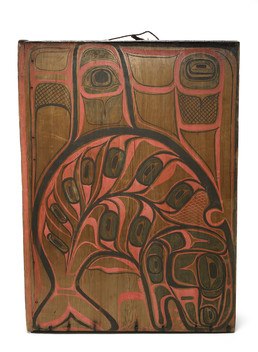
Tlingit beliefs were a well-organized system. They shaped how people saw and interacted with the world. Traditionally, Tlingit people believed that spirits lived in all things, a belief called animism. Hunters would perform rituals to purify themselves before hunting animals.
Shamans, usually men, played a key role. They helped heal illnesses and influenced the weather. Shamans also aided in hunting and predicted the future. A main belief was the reincarnation of both humans and animals.
Between 1886 and 1895, many Tlingit people became Orthodox Christians. This happened after their shamans struggled to treat new diseases like smallpox. Russian Orthodox missionaries translated their church services into the Tlingit language. Some believe Tlingit people chose Orthodox Christianity to resist being forced into the "American way of life." This American way was often linked with another Christian group, the Presbyterians.
Today, some young Tlingit people are exploring their traditional tribal religions. Many elders converted to Christianity. However, contemporary Tlingit often combine Christian beliefs with their traditional culture.
Tlingit Language
The Tlingit people speak the Tlingit language (Lingít). It is part of the Na-Dené language family. Lingít has a complex grammar and unique sounds.
Today, there are only about 300 to 500 native speakers of Tlingit. Most of these speakers also speak English. Many tribes, schools, and language experts are working hard to save and revive the Tlingit language. Programs exist in Southeast Alaska to teach and preserve this important part of Tlingit culture.
Tlingit Homes
Historically, Tlingit tribes built large plank houses. These homes were made from cedar wood. They are often called clanhouses today. These houses had foundations that allowed for storage under the floors. Clan houses were usually square or rectangular. They often had designs and totem poles on the front. These showed which clan and family group built the house.
Tlingit Economy and Work
Many Tlingit men work in the fishing industry. Women often work in canneries or create traditional handicrafts. These handicrafts include beautiful wood carvings and woven baskets. They are sold for practical use or to tourists.
Tlingit History
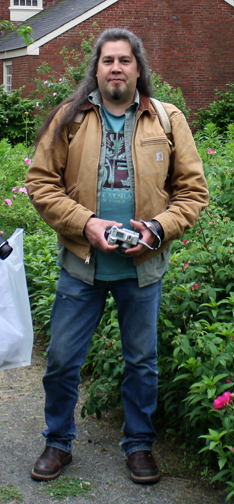
Indigenous people have lived in Alaska for thousands of years. The Tlingit culture developed from these ancient groups. The first time Tlingit people met Europeans was in 1741 with Russian explorers. Spanish explorers arrived later in 1775.
The Tlingit people kept their independence. However, diseases like smallpox, brought by Europeans, caused many Tlingit people to become very sick. These illnesses led to a significant loss of life within Tlingit communities.
Tlingit Food
Food is a very important part of Tlingit culture. The land and sea provide many resources. The rich life found on the beaches of Southeast Alaska can be harvested for food. However, eating only "beach food" was seen as a sign of poverty.
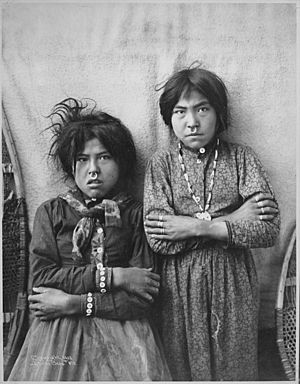
Salmon is the most important food source. Seal and other game animals are also very important. Halibut, shellfish, and seaweed provide food in the spring. Later in spring and summer, seals and salmon are harvested. Summer is also a time for gathering wild berries like salmonberry and currants. In the fall, sea otters are hunted.
Herring and eulachon are also key foods. They can be eaten fresh or dried for later. Fish provide meat, oil, and eggs. Sea mammals are used for food and clothing. In the forests, Tlingit people hunted deer, bear, and mountain goats.
Tlingit Ancestry
Scientists have studied the genes of Tlingit people. These studies suggest connections to ancient groups from Southern Siberia and to the Ainu people of Japan. This helps us understand how people moved and settled across the world long ago.
Notable Tlingit People
- Anna Brown Ehlers (born 1955), Chilkat weaver
- Todd Gloria (born 1978), politician
- Nora Marks Dauenhauer (1927–2017), poet, author, and scholar
- Ernestine Hayes (born 1945), poet, memorist, and professor
- Ursala Hudson, Chilkat and Ravenstail weaver
- Nathan Jackson (artist) (born 1938), woodcarver
- Esther Littlefield (1906–1997), artist, cultural interpreter
- Byron Mallott (1943–2020), Lieutenant Governor of Alaska (2014–2018)
- Da-ka-xeen Mehner, photographer and installation artist
- Larry McNeil (born 1955), photographer
- Tillie Paul (1863–1952), civil rights advocate and educator
- William Paul (1885–1977), attorney
- Elizabeth Peratrovich (1911–1958), civil rights advocate
- Clarissa Rizal (1956–2016), Chilkat and Ravenstail weaver
- Dino Rossi (born 1959), politician
- Martin Sensmeier (born 1985), actor
- Louis Shotridge (1883–1937), a Tlingit anthropologist and curator
- Preston Singletary (born 1963), glass artist
- Walter Soboleff (1908–2011), scholar, elder, and religious leader
- Jennie Thlunaut (c. 1891–1986), Chilkat weaver
- X'unéi (unknown), a powerful Yakutat chief
- Yeilxaak (unknown–1791), the first chief of Klukwan to meet Europeans
- Vera Starbard, playwright and author
- X̱ʼunei Lance Twitchell, scholar and author
See also
 In Spanish: Tlingit para niños
In Spanish: Tlingit para niños
- Chilkat weaving
- Ravenstail weaving
- Battle of Sitka (Tlingit Rebellion, 1802)
- History of the Tlingit
- Tlingit clans
- Alaska Native storytelling



